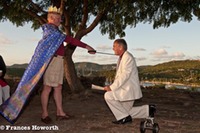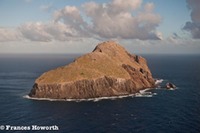Myth, Mystery & Fantasy
by John Duffy, Lord Plum, Chancellor to the King of Redonda
Redonda was discovered by Christopher Columbus in 1493 on his second voyage to the West Indies. He claimed the island for the Spanish crown naming it Santa Maria la Redonda but never landed. Centuries earlier the Caribs visited the island and called it Ocanamanru. In the 1860s the Redonda became a British possession.
In the late 19th Century, Redonda was occupied by up to 120 miners who prospected the island for phosphates. These operations ceased at the outbreak of the First World War. The island has not been occupied since. Remnants of the Post Office, which served the miners, still survive. Despite its history, it was not until 1929 that Redonda achieved its fame or, maybe, its infamy.
In that year, the publisher for Matthew Phipps Sheil, descendent of Montserrat merchant trader Matthew Dowdy Sheil, claimed, in a publicity stunt, that his author client was the King of Redonda. Shiel, a fairly prolific author of a number of horror and science fiction novels, was of somewhat limited appeal and, as a result, he was in the habit of re-issuing editions of previously printed books.
Like a number of minor authors, his popularity has increased since his death although, in his lifetime, he was credited with influencing H G Wells to produce the novel 'War in the Air' which was prescient of the Spanish Civil War in particular and, subsequently, World War II.
Endeavouring to sell four previously printed novels Shiel's publisher, Victor Gollancz, produced a publicity leaflet in which he stated that Shiel, at the age of 15, had been crowned King of Redonda.
According to Shiel, his father, descended from a long line of Irish Kings, decided to crown his son the King of Redonda. Had Shiel known that the 'legend' would still exist today, maybe, he would have better prepared his claim. Allegedly Shiel was crowned in 1880 by Bishop Semper of Antigua with Shiel taking the title of King Felipe. Unfortunately, at the time the Bishop of Antigua was named William Walrond Jackson and, in his many writings, Archbishop Jackson makes no mention of the coronation. There was a cleric by the name of Semper in Montserrat at that time and it can be presumed that Shiel remembered this priest's name and elevated him to the post of Archbishop to justify his claim to the crown.
A study of the Shiel family background would tend to indicate that far from being descended from Irish Kings they were more likely descendents of Irish criminals transported to St. Kitts in the 18th Century. In fact, Matthew Phipps Shiel spent some sixteen months in an English prison in 1914.
So, how did a publicity stunt in 1929 survive to this day with an organised succession and quite a number of claimants to the throne? The simple answer is that it is a literary succession and every literary personage demands recognition, justified or not.
What needs to be understood is that, before his death in 1947, Shiel determined that rather than the Kingship being hereditary it must be passed through a literary lineage, i.e., to another published author. To that end he transferred his Crown to the poet, John Gawsworth who assumed the title of Juan I.
Gawsworth was a dissolute character spending much of his time in London pubs bestowing knighthoods on anyone who would buy him a drink. Due to more or less permanent bankruptcy, Gawsworth made several attempts to sell the title. At least three advertisements appeared in The Times and, undoubtedly, there were many unrecorded attempts to raise funds from the title. As a result, the succession became somewhat confused.
In 1967 King Juan I (John Gawsworth) abdicated and Jon Wynne-Tyson assumed the title as Juan II, allegedly with the consent of King Juan I. The succession remained unchallenged although there are different 'history' records as to the sequence of the succession. Of one thing there can be no doubt, King Juan II authenticated his title by raising his standard on his Kingdom of Redonda, something even Shiel failed to do. Photographic evidence exists of King Juan II atop Redonda accompanied by renowned Antiguan historian, Desmond Nicholson.
Following the abdication of Juan II Bob Williamson, King Bob the Bald inherited the title. Not only did he meet the literary qualification but also, he had a navy and army based in Antigua and, most important of all, he raised his standard on Redonda, now a prerequisite to succeeding to the title.
On his death in 2009 King Bob left a signed and witnessed Deed assigning his Crown to Michael Howorth who, on coronation, took the title of King Michael the Grey. King Michael, after raising his standard over Redonda, was crowned at Fort Charlotte, Antigua by Archbishop Terrance Bowen on 12th December 2009. In a moving ceremony during which the King received a golden orb (gold painted pineapple) and the Sceptre of Office (gold painted sugar cane), King Michael stated that he would rule his Kingdom in the tradition of myth, mystery and fantasy of his predecessors.



